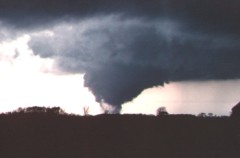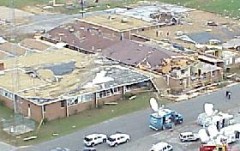Severe Weather Preparedness Guide for Schools
Severe weather preparedness is essential for all schools. These guidelines were developed for school administrators and emergency management personnel to help develop a preparedness plan that fits their school. Remember that there is no one solution that fits every case; every storm is different and may bring different threats.
A unique plan should be developed for your school using the guidelines below, your experience, and local considerations. However, if there is one idea that works in nearly all scenarios, it is this: "Put as many walls between you and the storm as possible."
Additional reference material is listed at the bottom of this page.
Before the Storm: Prepare and Practice
Perhaps the most important part in this process is being ready BEFORE severe weather strikes.
1) Educate yourself
Preparedness is easier when you understand the possible threat(s) and "lingo" used in the business. Do you know what a "WATCH" and WARNING" are? Educate yourself on severe weather and how the warning process works. This will help you understand the range of possibilities and limitations you have to plan for.
Hazardous Weather Outlooks (HWO) are issued daily from the National Weather Service (NWS) and can alert you of expected hazards out to seven days in the future. Outlooks are available in both graphical form or a text format. These outlooks are also broadcast over NOAA Weather Radio between 6 AM and Noon.
2) Develop an Action Plan
If you currently do not have a severe weather action plan for your school, developing the plan will be a large part of your preparedness work. In fact, this entire document could be considered part of the plan. Your county emergency management director or the National Weather Service (NWS) can assist in this process and provide guidance. The plan for your school will have to be tailored to your particular set up.

Physical Layout of School/Buildings - Closely examine the layout of your structure. You'll need to determine your designated shelter areas. Use a map of the school and physically tour the building(s) with your top school officials. You may also want to invite local fire department personnel, emergency management, or a building engineer to assist. Ideally students should be moved to the lowest level(s) possible, to interior rooms away from exterior walls and windows that may certainly fail in the event of a tornado or strong, damaging winds.
- Interior, small rooms usually offer the best protection. Offices or bathrooms are usually favored locations.
- Interior hallways are usually another good option, but avoid getting too close to outside door openings. If the hallway has glass doors at the end, it may not be a good choice. Hallways can also become a wind tunnel with dangerous debris flying through them. A hallway that zig-zags will be less likely to create a wind tunnel and should be relatively safer than a straight hallway.
- Avoid exterior class rooms or rooms with many windows.
- Avoid large span ceiling rooms like gymnasiums, auditoriums, and cafeterias. You have to assume ceiling failure will occur.
- Avoid portable classrooms.
Shelter Considerations - There are many things to consider when mapping out your shelter areas. Also take into account non-routine school activities or other times the buildings are being used.
- Travel Time - You should pick shelters where you can get students safely inside within three minutes. This will depend on the number of students, distance from the shelter, amount of space, etc.
- Size or Space - Ensure you have enough space to fit the number of students assigned to that shelter. Consider times of the day, class sizes, and special needs of students so you can handle each case. You may have to designate several shelters in different regions or zones of your building to accommodate everyone. Don't forget the school staff as well.
- Construction - Review the quality of construction to ensure sturdy protection. Look for possible failures in the ceilings. Rooms with a sky light should usually be avoided.
Notification - Develop a method to notify every one to seek shelter. It could be a speaker system, special tone, or bell, but ensure you have a backup method (air horn or megaphone) in the event you lose electricity. Ensure every one clearly knows what the notification signal is. Shelters should be clearly marked as such, with arrows directing people to the "safer" areas.
School Bus Considerations - Include in your plan what bus drivers should do while at the school or during transportation.
- Communication with the drivers is key via a central dispatch point or with school officials. Weather updates should be provided to give them advance notice of possible severe weather.
- Include them in your practice sessions.
- Drivers should be aware of possible shelters they can use if needed along their routes, such as caves, basements, study structures, etc.
- If a Tornado Watch is in effect, coordinate ahead of time what actions the bus drivers should take in case a tornado is sighted or warned for.

3) Practice and Review Your Action Plan
- You should practice and review your severe weather action plan relatively often. If your plan is new, a few practice run-throughs are suggested in case you need to revise shelter choices before finalizing it. A practice will not only help confirm the validity of your plan and illustrate any deficiencies to be addressed, but can educate your students and staff on proper responses during severe weather. Your plan should be reviewed at least annually, and anytime changes are made to the physical building, shelters, or classroom sizes. A good chance to practice is during the annual statewide Tornado Drills held in late March to mid-April each spring. Inform parents of your action plan which might involve students remaining or delayed at school beyond regular hours if severe weather is threatening.
4) Source of Weather Information

- Another key in being prepared is having a good and dependable source of weather information. Even the best action plan is no good if incoming severe weather weather or related warnings are not monitored. Whether you use commercial radio, television, private service, a community outdoor siren, or the Internet, you should have a NOAA Weather Radio as a direct source of watches and warnings directly from the National Weather Service. A weather radio continuously monitors the issuance of these types of alerts and can give you advance notice allowing you time to plan or activate your action plan. A desktop model can be placed in a central office allowing full monitoring by administrative staff. A weather radio also has a battery back-up in case of power loss. Be sure to educate your staff on what to listen for when the radio activates its alert tones. (A weather radio can also be used during the winter months to monitor wind chill conditions during extreme cold.) A program through the Dept. of Homeland Security provided weather radios to numerous schools across the country. Check this web site for additional information on this program - https://public-alert-radio.nws.noaa.gov/proginfo.htm. Make sure the weather radio or other source of weather information is available even during non-routine school activities. In 2002, a high school in north central Wisconsin was hit by a tornado but the school's football team that was holding a practice did not hear the warning because the weather radio was locked in the office. Like other aspects of proper preparation, a pro-active approach is needed when monitoring local weather conditions. Although warning lead times are increasing by the National Weather Service, you should not assume you will always receive a warning or "heads up" of threatening weather. If you spot a tornado or severe weather approaching, you should follow your action plans even if a warning is not heard. Consider attending a Skywarn severe weather spotter training class or designate staff members as spotters around your school. Bus drivers can benefit from this type of training as well so they can learn basic cloud formations that may be precursors of impending severe weather. Spotter training is held in March-May each year.
5) Other Preparation Ideas
- Close curtains and blinds before storms approach. The curtains or blinds may stop some debris from blowing in if the windows shatter.
- Consider postponing assemblies or other large gatherings if they involve use of large span roofs or rooms (gymnasiums, auditoriums, etc.).
During the Storm: Act
1) Monitor Weather Conditions

- Use your source of weather information to keep abreast of approaching storms, their severity, and reported severe weather. A NOAA Weather Radio will alert you if any watches or warnings are in effect or issued for your area. If a WATCH is issued, pay special attention to changing weather conditions and be ready to take action if a WARNING is issued or severe weather strikes. If your school has a designated storm spotter, have them be in position. Short range radios might be a good idea for communication between the spotter(s) and school administrator or office. If amateur radio operators or fire department personnel do storm spotting in your community, their radio traffic can be monitored via a scanner. That may be another option for real-time storm conditions.
2) Act!
- Respect all warnings and assume severe weather will strike your area. Be safe instead of sorry by treating all weather threats seriously. Understand that you will have false alarms but that is far better than not being ready when your facility is struck. Use your action plan by ensuring:
- Notification of impending severe weather is successful and complete, and
- Everyone seeks proper shelter or follows the school's plan as detailed.
If time allows, take note of problems that develop while the plan is being used.
Do not go near windows if severe weather is striking. Do not try to open windows or doors to equalize pressure. The pressure difference in a storm is not what damages buildings - it is the strong wind and flying debris associated with the storm or tornado that will cause damage and could explode glass or exterior walls.
Continue to monitor weather conditions until you are sure thunderstorms have passed.
School Bus Considerations -
- If buses are parked at the school and severe weather is expected shortly or occurring, do not let students leave the school or their shelters. Do not load the buses.
- If buses are in the middle of transporting, ensure they are notified of impending severe weather or active warnings.
- In the event of a tornado or very strong winds, the bus should be evacuated by moving the students to a shelter or building.
- When in open country, move the students off the bus and into a ditch. Move the bus away from where students are seeking refuge in case it is blown over or tossed.
After the Storm: Review
1) Damage Assessment

- Once you are confident the storm has passed, assess the building(s) for damage before releasing people from their shelters. Exterior areas, including playgrounds, should also be checked. Obviously if damage is noted, you may need to keep people in shelters or relocate them to safer areas.
2) All Clear
- Announce an "all clear" message or use pre-determined signals to alert sheltered students or staff that it is safe to return to their rooms.
3) Post Mortem Review
- After every use, consider conducting a post mortem review of your severe weather action plan and the actions your facility did during the weather event. What worked well? What can be improved? What problems were noted? Meet with your staff and review each action item. Adjust or append your plan as needed, just as you would after the spring drill or other practices. Additional reference or guidance may be available via your county emergency management director or the NWS.
Additional Reference Material






